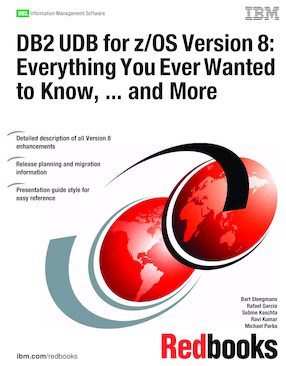DB2 UDB for z/OS Version 8: Everything You Ever Wanted to Know, ... and More
An IBM Redbooks publication
Note: This is publication is now archived. For reference only.

Published on 07 May 2004, updated 11 April 2005
ISBN-10: 0738497738
ISBN-13: 9780738497730
IBM Form #: SG24-6079-00
Authors: Bart Steegmans, Rafael Garcia, Sabine Kaschta, Ravi Kumar and Michael Parbs
IBM DATABASE 2 Universal Database Server for z/OS Version 8 is the twelfth and largest release of DB2 for MVS. It brings new synergy with the zSeries hardware and is the first major subsystem to exploit the z/OS 64-bit virtual addressing capabilities. DB2 V8 offers data support, application development, and query functionality enhancements for e-business, while building upon the traditional characteristics of availability, exceptional scalability, and performance for the enterprise of choice.
DB2 Version 8 has been re-engineered for e-business, with many fundamental changes in architecture and structure. Key improvements enhance scalability, application porting, security, and continuous availability. Management for very large databases is made much easier, while 64-bit virtual storage support makes management simpler and improves scalability and availability. This new version breaks through many old limitations in the definition of DB2 objects, including SQL improvements, schema evolution, longer names for tables and columns, longer SQL statements, enhanced Java and Unicode support, enhanced utilities, and many more advantages.
This IBM Redbooks publication introduces the many enhancements made available with DB2 V8. It will help you understand the functions offered by DB2 V8, and provides information to help you to evaluate their applicability to your environment, as well as to plan for the installation of DB2 V8 or the migration from DB2 V7.
Chapter 1. DB2 UDB for z/OS Version 8: At a glance
Chapter 2. Scalability
Chapter 3. Availability
Chapter 4. SQL enhancements
Chapter 5. e-Business
Chapter 6. Unicode in DB2 for z/OS
Chapter 7. Network computing
Chapter 8. Application enablement
Chapter 9. Utility enhancements
Chapter 10. Performance enhancements
Chapter 11. Data sharing enhancements
Chapter 12. Installation and migration
Appendix A. IBM DB2 DM Tools support
Appendix B. Unicode setup
Appendix C. Instrumentation enhancements